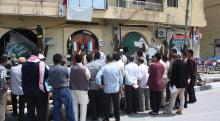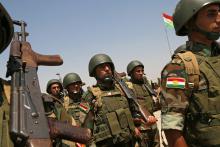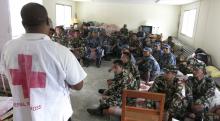Case prepared by David Köller, Clara Burkard, Matthew Brown, Angèle Jeangeorge and Eva Vaz Nave, LL.M. students at Leiden University, under the supervision of Professor Robert Heinsch as well as Sofia Poulopoulou, Christine Tremblay and Catherine Harwood (PhD researchers/research assistants), Kalshoven-Gieskes Forum, Leiden University.
A. THE CONDUCT OF THE WAR AND CIVILIAN CASUALTIES IN IRAQ
[…]
Both the U.S. and U.K. militaries took precautions to limit civilian casualties by establishing a process for vetting ground-launched cluster strikes.
[…]
The Third Infantry Division established another layer of review by sending lawyers to the field to review proposed strikes, a relatively recent addition to the vetting process. “Ten years ago, JAGs [judge advocate general attorneys] weren’t running around [the battlefield],” said Captain Chet Gregg, Second Brigade’s legal advisor. The division assigned sixteen lawyers to divisional headquarters and each brigade. Lead lawyer Colonel Cayce, who served at the tactical headquarters, reviewed 512 missions, and brigade JAGs approved additional attacks, which were often counter-battery strikes. Although less controversial strikes, such as those on forces in the desert, were not reviewed, Cayce said, “I would feel pretty confident a lawyer was involved in strikes in populated areas.” Commanders had the final say, but lawyers provided advice about whether a strike was legal under IHL. Cayce said his commander never overruled his advice not to attack and sometimes rejected targets he said were legal.
While the review process involved a careful weighing of military necessity and potential harm to civilians, limited information and the subjectivity of such an analysis meant it was “not a scientific formula.” The first challenge was to determine the risk to their forces. “The hard part is how many casualties we will take. It’s a gut level, fly by the seat of your pants. There’s no standard that says one U.S. life equals X civilian lives,” Cayce said. Then lawyers had to evaluate the threat to civilians. In the case of counter-battery fire, they had to make the judgment without knowing if civilians were present in the target area at the time of the strike; they relied instead on pre-war population figures. Cayce acknowledged the danger of cluster strikes on populated areas and said that he tried to limit them to night-time. “I was hoping kids were hunkered down, hoping with artillery fire they were not out watching,” he said.
B. COALITION TARGETING PROCEDURES
[Source: U.S. Department of State: Foreign Press Center Briefing, ‘Coalition Targeting Procedures’, 3 April 2003, available at: Link not available.]
[…]
QUESTION: Toby Harnden from the Daily Telegraph of London. Could I just ask a question about lawyers and the targeting process? You mentioned legal review.
Could I just ask you about the -- what involvement lawyers have in the process, at what level, and what kind of criteria that applied? I'd ask you whether you could give specific examples of occasions where lawyers had maybe vetoed a target.
And also, if you could perhaps comment on whether the legal -- and I think you also mentioned public relations considerations -- whether taking those into account may sometimes compromise the safety of coalition troops and compromise military aims; and also ask you to comment on the speed at which these decisions have to be made because there is a very, very complex process there. And, clearly, you're operating in real time, and sometimes you may have only minutes to make these decisions.
MAJ GEN McCHRYSTAL: Sure. Well, I remember about a third of that. But because I am not a lawyer, but I'll try to -- I'll try to cover it as best I can. First, we have lawyers at every level that review, that review targets. In the initial targeting process, those lawyers tend to be at the higher levels because you have time to make those kinds of decisions to review target lists before strikes.
So there tends to be a careful process where there is plenty of time to review that. And we produce what we call rules of engagement, which govern not only the targeting process, but all of the other actions of forces in the field. But, as it gets into practice, we have a number of things that we use that work.
First, we operate within those rules of engagement, and then we put together certain processes like time-sensitive targeting. And those are when you talk about the crush of an emerging target that might come up, that doesn't have time to go through a complicated vetting process, then the set of rules apply that says, in this particular case, these are the rules apply. And there still is a legal review, but it is all at a much accelerated process because there are some fleeting targets that require a very time-sensitive engagement, but they all fit into pre-thought out criteria.
In the end, it's a judgment call, clearly, because you are weighing -- most targets have come up, you have imperfect intelligence. But, in some cases, we raise the criteria for positive identification to the point where we do let some targets go; particularly, I came to this assignment from Afghanistan. Sometimes you make decisions to let potentially lucrative targets go simply because you are not sure enough to risk the loss of innocent lives or potential damage to achieve that end. And that's a measure of our strength that I think we are proud of.
QUESTION: What would be the lowest level which the lawyer will be operating in this process? I mean, do you have lawyers actually on the ground with -- I don't know -- captains and second lieutenants? I mean, what's the lowest level?
MAJ GEN McCHRYSTAL: No, we have lawyers all the way down to our maneuver divisions, and, in many cases -- well, we have them down in our maneuver brigades as well.
QUESTION: Do you have any of them actually on the ground in Iraq?
MAJ GEN McCHRYSTAL: Absolutely, at all of those levels, maneuvering with the element.
[…]
C. LEGAL SERVICES SUPPORT TO OPERATIONAL COMMANDERS
[
Source: Marine Corps Center for Lessons Learned, ‘Legal services support to operational commanders: a summary of observations and lessons from OEF/ OIF judge advocates and infantry commanders’
, 3 May 2006, p. 9,
http://info.publicintelligence.net/MarinesLegalSupport.pdf, footnotes omitted]
[…]
Commanding Officer Experience with Battalion Judge Advocates
When asked if they were able to “obtain the legal support they needed” during their most recent OEF/OIF [Operations “Enduring Freedom” and “Iraqi Freedom”, respectively] deployment, 91 percent of commanding officers who had an opinion answered in the affirmative. The same percentage, 91 percent of those who expressed an opinion, responded that they agreed with the statement that the “assignment of JAs [Judge Advocate] to infantry battalions was a force multiplier that enhanced the ability of the battalion to accomplish its mission.” The segment of the commanders who actually had a JA assigned to their battalion during their deployment (“Bn commanders with JAs”) was 43 percent, and among that group, the percentage who agreed that Bn JAs were a battalion “force multiplier” was 100 percent. The Bn commanders with JAs were also in 100 percent agreement with the statement “I feel that a JA should be assigned full time to infantry battalions during SASO [stability and support operations].”
D. LEGAL SUPPORT IN WAR: THE ROLE OF MILITARY LAWYERS
[…]
IV. A NEW PRACTICE FOR OPERATIONAL LAWYERS
The DODLOW [Law of War Program launched with the Department of Defense Directive issued by the Secretary of Defense of the US in 1974] changed the role of the military attorney. Early on, legal advisors had to overcome skepticism about their presence in the command center and earn the trust of commanders. Once this trust was earned, legal advisors began to be invited to planning groups, to participate in exercises, and to attend the commander's briefings. This development of trust and a place for the attorney was the origin of the “operational lawyer”: the attorney who supports the warfighting commander through expertise in those parts of international and operational law relevant to accomplishing the military mission (including the international law on the use of force). OPLAW [Operational Law] is that body of:
“[d]omestic and international law associated with the planning and execution of military operations in peacetime or hostilities. It includes, but is not limited to, Law of War, law related to security assistance, training, mobilization, predeployment preparation, deployment, overseas procurement, the conduct of military combat operations, anti- and counterterrorist activities, status of forces agreements, operations against hostile forces, and civil affairs operations.”
[…]
To provide the required support, the judge advocate participates in the commander's (and staff's) decision-making processes by performing mission analysis; preparing analysis of the potential legal issues (legal estimates); communicating and consulting with lawyers up and down the chain of command; providing training to the commander, the staff, and subordinate commanders/units/judge advocates; participating in war games; writing legal annexes to plans; assisting in the development and training of ROE [rules of engagement]; participating in the targeting process; and reviewing plans and orders. […]
Legal advisors whose portfolio includes international and operational law issues are found at all levels of command. Of course, within different organizations the staffs are organized differently and have different missions. The number and skill sets of assigned attorneys will reflect those differences. Thus, while the Office of the Secretary of Defense (“OSD”) has an extensive staff of legal advisors (almost all civilian), providing counsel on all matters under the Secretary's cognizance, a combatant commander will have approximately six to eight legal advisors (almost all uniformed) to handle the legal issues including OPLAW --relevant to such a staff. The common feature to all is that they provide legal and, when asked, policy counsel to a commander or other official.
[…]
OPLAW legal advisors are also found in the armed forces of countries around the world. Like the US, several countries include judge advocates on the staffs of their commanders. The US organization is similar to that found in British and Australian commands. Canada and France, among others, also deploy judge advocates to the field. Many other countries dedicate legal advisors to their forces, albeit from a greater distance. This network of lawyers helps bridge the gaps between individual national interests and the interests of the coalition by working to clarify ROE and other use of force issues so that commanders at all levels are aware of the capabilities of all the available forces.
[…]
Discussion
I. Classification of the Situation and Applicable Law
II. Conduct of Hostilities and Availability of Legal Advisers
2. Is there an obligation under IHL to make legal advisers available? When exactly do they need to be available? To advise who? Do all commanders need a legal adviser? (
AP I, Art. 82;
CIHL, Rule 141)
3. Is the advice of the legal advisers binding upon the military commanders? How can opinions of legal advisers and commanding officers be reconciled? Should legal advisers have a veto in the targeting procedure?
4. (Documents A, B and D) What are the advantages, or risks, to the presence of lawyers on the ground, “running around [the battlefield]” with the military, rather than providing the legal advice on distance?
5. (Documents A and B) If there is no “scientific formula” to weight military necessity and potential harm to civilians, how do you think the lawyers analyse legality of potential attacks?
6. (Document A) Do all lives “equal the same” under the IHL rules on targeting?
III. Elements Contributing to Respect for IHL
7. (Document A) In your opinion, what could have been the reason behind the commander rejecting some of the targets that the legal advisers have said to be “legal”?
8. (Document B) Why do you think General Major McChristal sees the examples of compliance with the law as “a measure of […] strength [of the armed forces]” and something to be proud of? What is the interrelationship between military routine, discipline and efficiency and compliance with IHL?
9. (Document C) Why do you think 91 percent of the commanding officers agreed with the statement that the “assignment of JAs to infantry battalions was a force multiplier that enhanced the ability of the battalion to accomplish its mission”? In your opinion, how does availability of legal advisers enhance the abilities of the military?
10. What influence, if any, does the increased public availability of information relating to warfare have on the development of the role of legal advisers? (Document B) How do “public relations considerations” influence the decisions of the military?
11. (Document D) In your opinion, do joint or coalition military operations and the need for coordination among the participating states influence the creation of an organised system of legal advisers?
12. Do you think there is an added value in having common rules of engagement when it comes to coalition of forces? Can the existence of such rules contribute to compliance with IHL?






